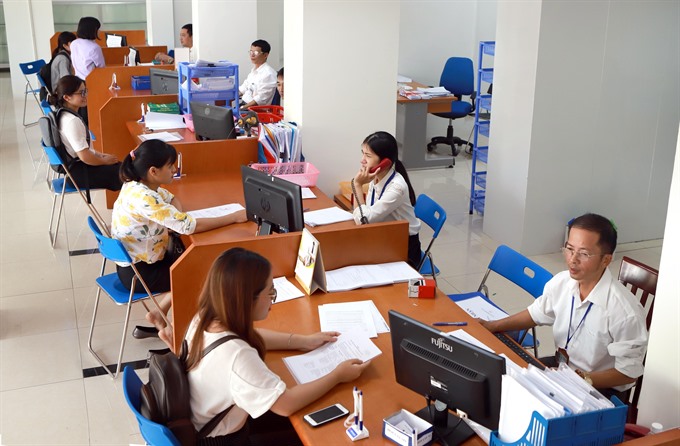 Economy
Economy

National Assembly (NA) deputies have expressed worries that the State budget income from tax collection is declining while economic development is too reliant on exploiting natural assets.
 |
| People complete tax procedures at the Hà Nội Tax Department. — VNA/VNS Photo Hoàng Hùng |
HÀ NỘI — National Assembly (NA) deputies have expressed worries that the State budget income from tax collection is declining while economic development is too reliant on exploiting natural assets.
According to the Government’s report to the deputies, total income of the State budget over the past five financial years is estimated at VNĐ6.86 trillion (US$305 million) and the Government estimates to have collected VNĐ3.75 trillion over the past three years.
NA deputies have been worried about the possibility that the Government will not reach its budget income target in the next two years.
The budget income for the next two years is forecast to reach at least VNĐ3.11 trillion, including VNĐ1.4 trillion collected in 2019. The figure for 2020 is VNĐ1.7 trillion, which is “a difficult target” for the State budget, according to NA deputy Trần Văn Tiến from Vĩnh Phúc Province.
Another issue is the tax collection/GDP ratio, for which the Government has set an annual target of 21 per cent until 2020, but has shown signs of declining after the past three years.
The Government’s report showed the ratio was 20.4 per cent in 2016, 20.2 per cent in 2017 and it is expected to hit 20.7 per cent in 2018 and 20 per cent in 2019.
That trend has raised concerns about the possibility of tax loss, fraud and avoidance among companies, Tiến said.
Domestic production is another problem for the State budget, NA deputy Bùi Thị Quỳnh Thơ from the central province of Hà Tĩnh said.
In 2019, the public sector’s contribution to the State budget is expected to grow 10 per cent year on year. The comparable figure for the foreign direct investment (FDI) sector is 13 per cent and 13.3 per cent for the non-State sector.
But the three core sectors have recorded low performances so far in 2018. For example, budget income from the FDI sector fell VNĐ33.64 trillion or 15.1 per cent year on year.
Most of the budget income has come from selling crude and leasing or selling land, according to NA deputy Leo Thị Lịch from Bắc Giang Province.
“We have to clarify why the three core sectors have underperformed,” Lịch said.
“The Government and local authorities have to do strict budget estimates so that the balance between spending and income and the macro-economic conditions are sustained” as Việt Nam is further integrating in the world’s economy with less barriers of taxes and tariffs, thus the decline of taxes and tariffs has had negative impacts on the budget income, he added.
Contractor payments
The Government must prioritise debt payments to contractors for civil procurement orders so that local businesses can avoid losses, and even worse, bankruptcy, according to Vũ Tiến Lộc, National Assembly (NA) deputy from Thái Bình Province.
Lộc, also the Chairman of the Việt Nam Chamber of Commerce and Industry (VCCI), told the NA on Monday that late payments to contractors is one of the issues that has emerged from the Government’s poor investment performances.
“The Government’s poor performances in State-funded projects have not improved in recent years” though the Government’s report to the NA has stated incremental capital-output ratio (ICOR) fell to only 6.11 in 2015-17 from 6.36 in 2011-14, he said.
“That’s not a big ICOR decline. Costing six units to produce one unit of growth proves the capital use has remained inefficient,” Lộc said.
Some projects are not urgently needed at the moment but still under construction, such as public squares and statues. Budget resources have been distributed to provinces, cities and sectors based on their size, not on the overall strength of the economy, he added.
In addition, a number of projects have remained inefficient, scattered and not connected, and resulted in delays, overspending and low-quality projects, making the local authorities unable to pay the costs, he said.
Lộc praised the Government’s efforts to propose the draft amended law on public investment.
However, he highlighted the draft law has only focused on cutting the number of procedures while issues on how to hold the stakeholders accountable for raising the quality of public projects have been undermined.
“If we continue like this, the higher our budget spending goes, the higher our budget deficit and public debt will be. So I strongly recommend other deputies should review the draft law carefully and thoroughly before approving it.”
The Government should develop a law on public-private partnership (PPP) so that local authorities and private firms are able to join and improve the efficiency of the public projects, he added.
In response to Lộc and other NA deputies, Minister of Planning and Investment Nguyễn Chí Dũng said the Government had completed payments totalling VNĐ9 trillion to local contractors and VNĐ50 trillion in counterpart capital before December 31, 2014.
“Any figures relating to civil procurement debts owed to local contractors from January 1, 2015 are unofficial numbers,” minister Dũng said.
Land clearance fund
Should the Government approve the land clearance project for the Long Thành International Airport in November, it will provide the southern province of Đồng Nai with VNĐ23 trillion (US$1 billion) for land clearance.
The land clearance proposal was submitted twice this year in March and July and is pending the Government’s approval, Minister of Transport Nguyễn Văn Thể told the National Assembly (NA) on Monday.
Meanwhile, the Ministry of Transport has organised an international bid to select contractors and consultants for the first phase of the airport project, Thể said.
Five contractors, including two domestic ones and three from Japan, are developing a plan for the project, he said, adding that the plan would be completed in July 2019 and submitted to the NA in October 2019.
In October 2017, the Government and NA decided to split the Long Thành International Airport project into two different parts and assigned the project to Đồng Nai Province and transport ministry.
Meanwhile, the construction of the key Eastern North-South Expressway may start in 2020, one year later than the expected schedule, the minister said.
The project was approved by the NA in Resolution 52 on October 22, 2017 and assigned to the transport ministry in December 2017. The ministry then spent two months organising a bid to select the suitable contractors and consultants.
There are 11 sub-projects of the expressway project so it will take quite some time to develop specific plans for them and implement those plans, he said.
Five of the 11 sub-projects have been approved by the transport ministry, while five others are pending for the Government’s approval and they are expected to get approved in November, he added.
The remaining sub-project, the Mỹ Thuận 2 Bridge, is also expected to get approved by the Government in 2018 because this is a large-scale project and it will take time for development, Thể said.
In January 2019, VNĐ14 trillion will be disbursed to local authorities for land clearance after the ministry hands over the plan to them, according to minister Thể.
Another VNĐ27 trillion worth of investment in the 654km expressway project would be disbursed in September 2019 and paid on the work progress after the ministry selects international and local contractors for the eight private-public partnership (PPP) sub-projects, he added. — VNS




